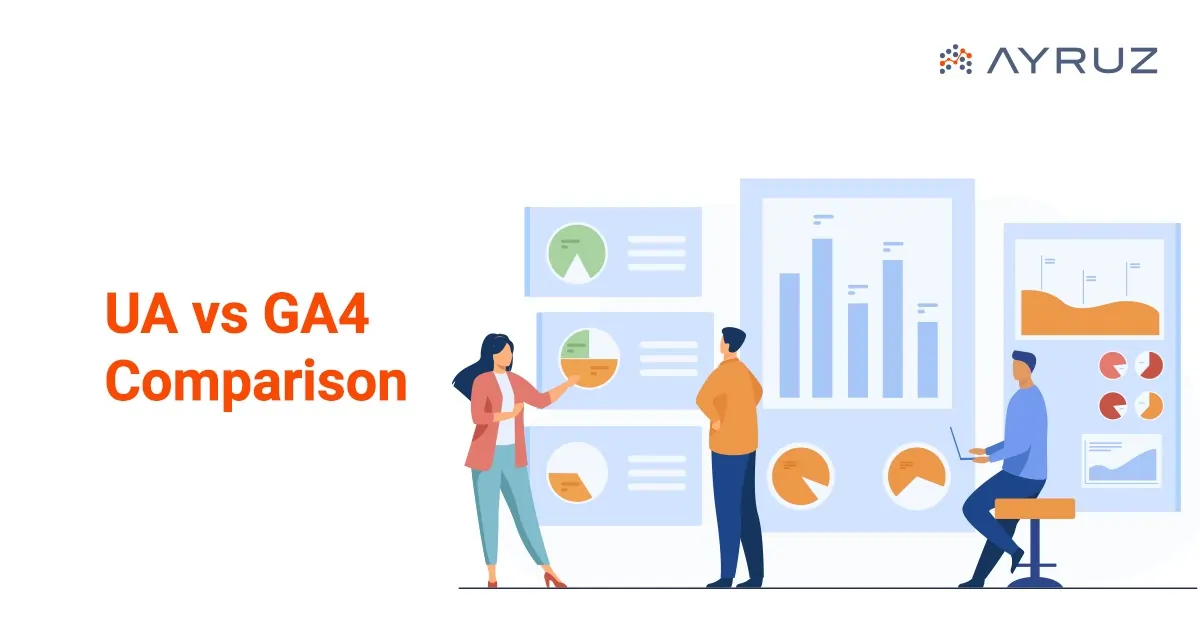Table of Contents
Web analytics has become essential to digital marketing, helping businesses gain insights into their website’s performance and user behaviour. With the evolution of analytics platforms, Google has introduced a new version called Google Analytics 4 (GA4), which brings significant changes compared to its predecessor, Universal Analytics. Here, we will explore the differences between Universal Analytics and GA4, focusing on key points such as app tracking, hit types, session calculations, exports to BigQuery, bounce rate and engagement rate, the importance of Google Tag Manager, and account structure.
- App Tracking: One of the significant differences between Universal Analytics and GA4 is the ability to track apps. While Universal Analytics primarily focuses on web tracking, GA4 provides enhanced app-tracking capabilities. GA4 allows businesses to track user behaviour within their mobile apps, including in-app events, screen views, and conversions. This feature enables businesses to gain insights into user engagement and retention within their apps, making GA4 a more comprehensive analytics solution for businesses with mobile apps.
- Hit Types: Hit types are how data is sent to Google Analytics for measurement. In Universal Analytics, hit types include pageviews, events, social interactions, e-commerce transactions, and more. However, in GA4, the concept of hit types has been simplified and replaced with events. Events in GA4 can capture various interactions, including pageviews, clicks, video views, scroll depth, and more. This streamlined approach allows for easier implementation and more flexibility in tracking user interactions.
- Session Calculations in GA4 vs Universal Analytics: Sessions are the periods of time in which users interact with a website or app. In Universal Analytics, a session is defined by default as 30 minutes of inactivity or the end of the day. However, in GA4, the concept of sessions has changed. GA4 uses an event-based model, where a session is a collection of user interactions with the same session ID, regardless of the time interval between interactions. This means that in GA4, a session can span across multiple days, making it more flexible and better suited to track user behavior in the modern multi-device, multi-channel digital landscape.
- Exports to BigQuery are free with Google Analytics 4: Another notable difference between Universal Analytics and GA4 is the ability to export data to BigQuery, Google’s cloud-based data warehouse, for advanced analysis. In Universal Analytics, exporting data to BigQuery requires a paid integration with Google Analytics 360. However, in GA4, data exports to BigQuery are free, making it more accessible for businesses to analyze and gain insights from their data in a powerful and scalable data warehousing solution.
- Bounce Rate and Engagement Rate: Bounce rate is a metric that measures the percentage of users who leave the website after viewing only one page, while engagement rate measures the level of user interaction on a website. In Universal Analytics, these metrics are calculated based on pageviews, while in GA4, they are calculated based on events. This means that in GA4, businesses can have more accurate and granular insights into user engagement. Events can capture interactions beyond pageviews, such as clicks and video views.
- Google Tag Manager is more important than ever: Google Tag Manager (GTM) has always been a valuable tool for managing tracking codes and implementing analytics on websites and apps. However, with the introduction of GA4, GTM has become even more important for businesses that want to make the most of their data-driven strategies.
One of the key reasons why GTM has gained increased importance with GA4 is the shift toward an event-based tracking model. In GA4, events are the primary data points tracked, replacing traditional pageviews and other hit types in Universal Analytics. Businesses must carefully configure and manage their events in GTM to ensure accurate tracking of user interactions, conversions, and other important events.
GTM also allows businesses to implement GA4’s enhanced app tracking capabilities easily. With GA4, businesses can track user interactions within their mobile apps, such as button clicks, in-app purchases, and app opens. GTM simplifies adding event tracking codes to the app’s source code, making it easier for businesses to implement and manage app tracking in GA4.
Furthermore, GTM allows businesses to adapt and update tracking configurations without changing their website or app’s source code. This means businesses can easily update their tracking setup, add new events, and make other changes as needed, all through the GTM interface, without requiring developer involvement. This agility and flexibility make GTM a powerful tool for businesses that want to quickly iterate and optimize their tracking setups based on their evolving data needs.
In addition, GTM offers a robust testing and debugging environment, which is essential for ensuring that tracking codes are working correctly and data is accurately captured in GA4. Businesses can use GTM’s built-in preview and debug mode to test their tracking configurations and troubleshoot any issues before deploying changes to their live website or app.
Overall, GTM has become more important than ever with GA4, providing businesses with the necessary flexibility, agility, and testing capabilities to implement and manage their event-based tracking setup effectively. It allows businesses to efficiently configure and deploy tracking codes, test and debug tracking configurations, and adapt their tracking setups. It is a crucial tool for businesses that want to maximize the benefits of GA4’s advanced analytics capabilities.
- Better Search With the GA4 Search Bar: Another notable feature of GA4 is including a search bar within the platform. This search bar allows users to easily search for specific events, conversions, or other data points within their GA4 account, making finding relevant information more efficient and convenient. This feature is particularly useful for businesses with large amounts of data or complex tracking setups. It allows for quicker and more precise searches, making data analysis and reporting more streamlined.
- Account Structure: The account structure in GA4 has also been updated compared to Universal Analytics. Universal Analytics’s account structure consists of accounts, properties, and views. However, GA4’s account structure is simplified to just organizations and properties. Organizations serve as top-level entities and can have multiple properties representing the websites, apps, or other tracked digital assets. This updated account structure gives businesses a more streamlined and organized approach to managing their analytics properties, making setting up and managing to track multiple assets easier.
Conclusion: If you’re considering switching to GA4, partnering with a GA4 agency can help you navigate the complex migration process and fully leverage the platform’s capabilities. In conclusion, GA4 introduces significant changes and improvements compared to Universal Analytics. With enhanced app tracking capabilities, streamlined hit types, event-based session calculations, free exports to BigQuery, updated metrics like bounce rate and engagement rate, the increased importance of Google Tag Manager, and improved search capabilities within the platform, The web analytics approach provided by GA4 is more modern and comprehensive in comparison to Universal Analytics. However, the transition from Universal Analytics to GA4 may require businesses to adapt their tracking setups and familiarize themselves with the updated features and account structure. A GA4 agency can provide guidance and expertise to ensure a smooth transition and help businesses fully leverage the capabilities of GA4 for their data-driven decision-making. To fully utilize GA4’s potential, companies must thoughtfully evaluate their particular needs and preferences when deciding between Universal Analytics and GA4 and plan a seamless transition accordingly.



.png)






